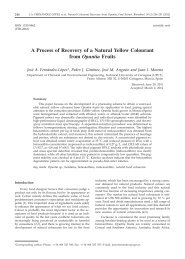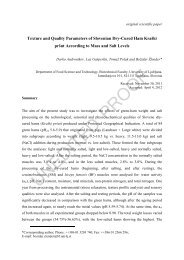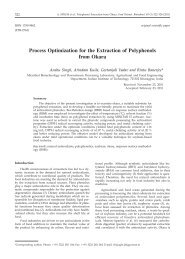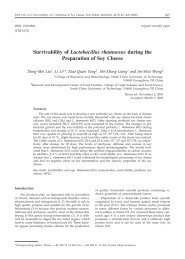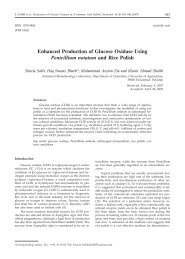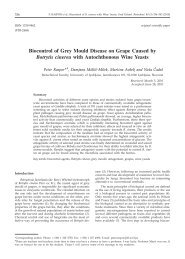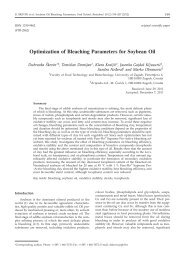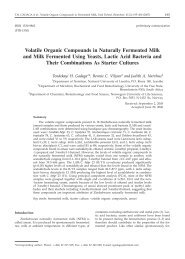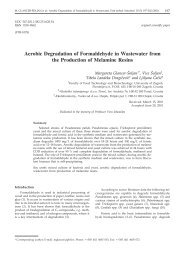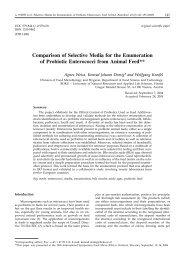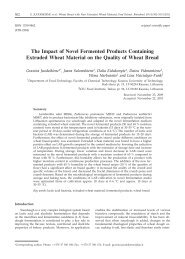Antioxidant Capacity and Phenolic Content of Essential Oil Obtained ...
Antioxidant Capacity and Phenolic Content of Essential Oil Obtained ...
Antioxidant Capacity and Phenolic Content of Essential Oil Obtained ...
You also want an ePaper? Increase the reach of your titles
YUMPU automatically turns print PDFs into web optimized ePapers that Google loves.
FTB-3184<br />
original scientific paper<br />
<strong>Antioxidant</strong> <strong>Capacity</strong> <strong>and</strong> <strong>Phenolic</strong> <strong>Content</strong> <strong>of</strong> <strong>Essential</strong> <strong>Oil</strong><br />
<strong>Obtained</strong> by Microwave-Assisted Hydrodistillation from<br />
Sawdust <strong>of</strong> Chamaecyparis obtusa<br />
Vivek K. Bajpai 1# , Ajay Sharma 1# , Sung Hong Kim 2 <strong>and</strong> Kwang-Hyun Baek 1∗<br />
1 School <strong>of</strong> Biotechnology, Yeungnam University, Gyeongsan, Gyeongbuk 712-749,<br />
Republic <strong>of</strong> Korea<br />
2 Analysis Research Division, Daegu Center, Korea Basic Science Institute,<br />
Daegu 702-701, Korea<br />
Received: September 3, 2012<br />
Accepted: December 19, 2012<br />
Summary<br />
Reactive oxygen species <strong>and</strong> free radicals play a major role in food deterioration.<br />
Current research is directed towards finding naturally occurring antioxidants <strong>of</strong> plant origin.<br />
In the present study, the chemical composition analysis <strong>of</strong> the essential oil obtained from<br />
sawdust <strong>of</strong> Chamaecyparis obtusa (COEO) was conducted by gas chromatography <strong>and</strong> mass<br />
spectroscopy (GC-MS). Further, the antioxidant capacity <strong>and</strong> phenolic content <strong>of</strong> the COEO<br />
UNEDITED PROOF<br />
were investigated using different radical scavenging assays. The COEO obtained from the<br />
dried “sawdust” material using a microwave-assisted hydrodistillation technique resulted in<br />
the determination <strong>of</strong> 46 different compounds by GC-MS analysis, representing 98.94 % <strong>of</strong><br />
total oil. The COEO was characterized with the presence <strong>of</strong> mono- <strong>and</strong> sesquiterpene<br />
hydrocarbons, oxygenated mono- <strong>and</strong> sesquiterpenes, steroids, diterpenes <strong>and</strong> indole<br />
# Both authors contributed equally to this research work<br />
∗ Corresponding author; Fax: ++82 53 810 4769; E-mail: khbaek@ynu.ac.kr<br />
1
derivatives. The COEO at the highest tested concentration range (500, 500, 250 <strong>and</strong> 500<br />
µg/mL) showed antioxidant capacity as the inhibition <strong>of</strong> DPPH, nitric oxide, superoxide <strong>and</strong><br />
hydroxyl radicals by 80.16 %, 82.93 %, 72.99 % <strong>and</strong> 71.62 %, respectively. Moreover, the<br />
COEO displayed concentration-dependent reducing power ability <strong>and</strong> remarkable inhibitory<br />
effect on ferric ion-induced lipid peroxidation in bovine brain extract. In addition, the COEO<br />
yielded 6.13±0.05 mg gallic acid / g dry weight sample. The present study confirms that the<br />
C. obtusa essential oil (COEO) had potent antioxidant, inhibit lipid peroxidation <strong>and</strong> radical<br />
scavenging ability; therefore, it might be used as a natural antioxidant against food<br />
deterioration.<br />
Key words: Chamaecyparis obtusa, essential oil, microwave extraction, reactive oxygen<br />
species, free radicals, antioxidant<br />
Introduction<br />
In living organisms there is an equilibrium between natural antioxidant defense<br />
mechanism <strong>and</strong> reactive oxygen species (ROS), which are produced in the body by various<br />
exogenous <strong>and</strong> endogenous redox cycling processes as by-products (1). When the equilibrium<br />
is disturbed, the ROS can induce oxidative damage to various biomolecules, including<br />
carbohydrates, lipids, proteins, DNA <strong>and</strong> RNA in the human body associated with cellular<br />
damage, tissue injury <strong>and</strong> genetic mutation (2). This oxidative damage may accelerate aging,<br />
cancer, cardiovascular disorders, inflammation <strong>and</strong> neurodegenerative disorders (3, 4).<br />
It has been recognized that lipid peroxidation is a major factor <strong>of</strong> food deterioration<br />
UNEDITED PROOF<br />
during processing <strong>and</strong> storage which affects food quality severely, causing qualitative<br />
deterioration <strong>of</strong> food commodities because <strong>of</strong> chemical spoilage, rancidity, <strong>and</strong> altered<br />
physical properties including color <strong>and</strong> texture alterations (4). Consecutively to protect foods<br />
<strong>and</strong> human individual against oxidative damage caused by ROS, synthetic antioxidants such<br />
as butylated hydroxyl anisole (BHA), propyl gallate, <strong>and</strong> butylated hydroxyl toluene (BHT)<br />
have been added to foodstuffs (5). However, due to toxicity <strong>and</strong> potential health hazards <strong>of</strong><br />
synthetic antioxidants as well as their limited use, interest has been considerably increased for<br />
finding naturally occurring antioxidant compounds for using in foods <strong>and</strong>/or medicines (6).<br />
There are epidemiological evidences correlating higher intake <strong>of</strong> dietary antioxidant<br />
2
components with the ability to lower the incidences <strong>of</strong> various human morbidities or<br />
mortalities (7).<br />
In the recent past, there has been an increasing significance in the therapeutic<br />
efficacy <strong>and</strong> preservative properties <strong>of</strong> natural plant antioxidants to prevent oxidative<br />
reactions both in food stuffs <strong>and</strong> in biological systems. The plant-based essential oils have<br />
provoked interest as the sources <strong>of</strong> natural products because <strong>of</strong> their safety, wide consumer’s<br />
acceptability, <strong>and</strong> the likelihood <strong>of</strong> their exploitation for potential versatile functional uses (7-<br />
9). The plant-based volatile oils <strong>and</strong> non-volatile secondary metabolites have wide<br />
applications in dietary supplements, food flavoring <strong>and</strong> preservation, folk medicine <strong>and</strong><br />
fragrance industry (10, 11). Several reports have confirmed the antioxidant capacity <strong>of</strong> plantbased<br />
essential oils in vitro <strong>and</strong> in vivo (12, 13).<br />
The essential oils derived from plants have been screened for their potential uses as<br />
an alternative remedies for the treatment <strong>of</strong> many infectious diseases <strong>and</strong> the preservation <strong>of</strong><br />
foods from the toxic effects <strong>of</strong> oxidants (6). Moreover, they propose an efficient way to<br />
prevent the development <strong>of</strong> rancidity <strong>and</strong> harmful compounds that consequence from lipid<br />
peroxidation <strong>of</strong> foods (14). <strong>Essential</strong> oils are complex mixtures <strong>of</strong> biologically active volatile<br />
substances. Conventional extraction methods <strong>of</strong> essential oils such as tumbling <strong>and</strong> shaking,<br />
oil infusion, cold expression, steam distillation <strong>and</strong> Soxhlet extraction is time consuming, less<br />
efficient, <strong>and</strong> require more amounts <strong>of</strong> solvents for extraction purposes. Moreover, losses <strong>of</strong><br />
some volatile components, thermal or hydrolytic degradation <strong>of</strong> unsaturated or ester<br />
compounds <strong>and</strong> toxic solvent residue in the sample may be encountered using these<br />
extraction methods. These shortcomings have led to the consideration <strong>of</strong> the use <strong>of</strong> a new<br />
“green” technique such as the application <strong>of</strong> microwaves, for essential oil extraction which<br />
typically uses less energy <strong>and</strong> is free from harmful effects <strong>of</strong> organic solvents (15). This<br />
UNEDITED PROOF<br />
unique heating mechanism can significantly reduces the extraction time as compared to<br />
conventional extraction methods (16). In microwave-assisted hydrodistillation technique, the<br />
moisture content in the substrate sample serves as the target for microwave heating. The<br />
moisture when heated up inside the plant cell due to microwave effect, it evaporates <strong>and</strong><br />
generates remarkable pressure on the cell wall due to swelling <strong>of</strong> the plant cell (17). The<br />
pressure pushes the cell wall from inside, stretching <strong>and</strong> ultimately rupturing it, which<br />
facilitates leaching out <strong>of</strong> the active constituents from the ruptures <strong>of</strong> the gl<strong>and</strong>ular <strong>and</strong><br />
oleiferous vesicles to the surrounding solvent thus improving the yield <strong>of</strong> phyto-constituents.<br />
3
Especially this technique has great advantage over extracting essential oils from hard-shell<br />
nuts or the rigid parts <strong>of</strong> the samples without any disruption <strong>of</strong> tissues prior to the extraction<br />
<strong>of</strong> oil (17).<br />
Chamaecyparis obtusa, commonly known as Hinoki, is a conifer in the cypress<br />
family, Cupressaceae, native to Northeast Asia <strong>and</strong> is rich in a variety <strong>of</strong> active<br />
pharmaceutical ingredients such as flavonoids <strong>and</strong> other essential components (18, 19). The<br />
oils extracted from the leaves <strong>and</strong> twigs <strong>of</strong> C. obtusa have been commercially used in soap,<br />
toothpaste <strong>and</strong> cosmetics as functional additives due to their potent fragrance nature (18). The<br />
essential oil from C. obtusa leaf possesses wide spectrum antimicrobial activity against<br />
various fungal pathogens <strong>and</strong> pathogenic bacteria as well as having allelopathetic <strong>and</strong><br />
insecticidal potentials (20-22).<br />
The “sawdust” is a by-product <strong>of</strong> cutting, grinding, drilling or other pulverizing<br />
woods. The sawdust processing could be a possible scientific approach to enhance the<br />
biological efficacy <strong>of</strong> such cheap <strong>and</strong> easily accessible waste materials as the primary<br />
substrates in order to develop new practical tools in the search <strong>of</strong> naturally-occurring safe <strong>and</strong><br />
effective biological products. In addition, smaller particle size <strong>and</strong> smooth texture properties<br />
<strong>of</strong> “sawdust” make it a better c<strong>and</strong>idate for the extraction <strong>of</strong> bioactive compounds present in<br />
such types <strong>of</strong> substrate products as compared to the whole wood, wooden chips or timber<br />
having hard or rigid physical properties. Moreover, recycling <strong>of</strong> wooden “sawdust” is also<br />
possible to perform in a direction <strong>of</strong> obtaining other useful products such as saccharides <strong>and</strong><br />
turpentine etc (23). In the United States, 98 % <strong>of</strong> the bark, saw dust, <strong>and</strong> wood trimmings<br />
from sawmill operations, <strong>and</strong> the black liquor produced in the pulping process, are currently<br />
used as fuel or to produce other fiber products (24).<br />
Literature survey has confirmed that there is very little literature report available on<br />
UNEDITED PROOF<br />
the antioxidant <strong>and</strong> free radical scavenging capacities <strong>of</strong> essential oil obtained from sawdust<br />
<strong>of</strong> Chamaecyparis obtusa (COEO) extracted by the microwave-assisted hydrodistillation<br />
technique. However, other “sawdust” essential oils isolated from different plant materials<br />
have showed numerous biological activities (25, 26). Also the essential oil obtained from<br />
“sawdust” <strong>of</strong> Cedrus deodara has been found to possess potential usefulness in aromatherapy<br />
(27). In addition, owing to the complexity <strong>of</strong> the oxidation-reduction processes, it is obvious<br />
that no single testing method is capable <strong>of</strong> providing a comprehensive picture <strong>of</strong> the<br />
antioxidant pr<strong>of</strong>ile <strong>of</strong> a studied sample. Hence, in the present study, a multi-method approach<br />
4
was applied for the assessment <strong>of</strong> antioxidant capacity <strong>of</strong> the test sample.<br />
In this study, a microwave-assisted hydrodistillation method was applied to isolate<br />
the essential oil obtained from sawdust <strong>of</strong> C. obtusa. The objective <strong>of</strong> the present study was<br />
to evaluate the antioxidant potential <strong>and</strong> free radical scavenging capacity <strong>of</strong> COEO using<br />
various in vitro models including DPPH, nitric oxide, superoxide <strong>and</strong> hydroxyl radicals as<br />
well as lipid peroxidation assay followed by determination <strong>of</strong> its reducing power ability <strong>and</strong><br />
total phenolic content. Furthermore, the chemical composition analysis <strong>of</strong> COEO was<br />
performed using gas chromatography-mass spectrometry (GC-MS) analysis.<br />
Materials <strong>and</strong> Methods<br />
Chemicals <strong>and</strong> instrument<br />
The chemicals <strong>and</strong> reagents used in this study included bovine brain extract, 2,2-<br />
diphenyl-1-picrylhydrazyl (DPPH), 2-deoxy-2-ribose, ferric chloride, Folin-Ciocalteu reagent,<br />
gallic acid, Griess reagent, nitro blue tetrazolium (NBT), phenazine methosulphate (PMS),<br />
potassium ferricyanide, sodium nitroprusside (SNP) <strong>and</strong> trichloroacetic acid (TCA), as well<br />
as st<strong>and</strong>ard antioxidant compounds ascorbic acid, BHA <strong>and</strong> α-tocopherol. All chemicals <strong>and</strong><br />
reagents were <strong>of</strong> analytical grade <strong>and</strong> purchased from Sigma-Aldrich (St. Louis, USA).<br />
Spectrophotometric measurements were done by using a 96-well microplate ELISA reader<br />
(Infinite M200, Tecan, Mannedorf, Switzerl<strong>and</strong>).<br />
Plant material <strong>and</strong> extraction<br />
The wooden sawdust <strong>of</strong> Chamaecyparis obtusa (Siebold & Zucc.) Endl. was<br />
UNEDITED PROOF<br />
purchased from a local plumber company specialized in processing timber materials <strong>of</strong> C.<br />
obtusa, <strong>and</strong> a voucher specimen number was deposited in the library <strong>of</strong> Yeungnam University,<br />
Korea. The sawdust material was dried under shade at room temperature. The dried sawdust<br />
(200 g) sample was immersed in water (2 liter) which was subjected to hydrodistillation using<br />
a microwave-assisted extraction apparatus for a period <strong>of</strong> 2 h. The microwave extraction<br />
apparatus was especially manufactured by the KMD Engineering, Yangju-si, Korea. The<br />
commercial microwave apparatus was fitted with automated thermo controller system having<br />
oven power capacity <strong>of</strong> 40 W, operating at the frequency <strong>of</strong> 15 GKH (Fig. 1). The distillate<br />
was collected <strong>and</strong> mixed with dichloromethane, shaken <strong>and</strong> kept in a separating funnel. The<br />
5
lower layer <strong>of</strong> dichloromethane containing the essential oil was collected <strong>and</strong> evaporated<br />
using rotary evaporator at room temperature to give essential oil. Eventually, the oil was dried<br />
over anhydrous sodium sulphate (Na 2 SO 4 ) <strong>and</strong> preserved in a sealed vial at 4 °C until tested<br />
<strong>and</strong> analyzed.<br />
Analysis <strong>of</strong> COEO by gas chromatography-mass spectrometry (GC-MS)<br />
The detailed chemical composition <strong>of</strong> the COEO was analyzed using a GC/MS (JMS<br />
700 mass spectrometer, Jeol USA, Inc., Peabody, MA, USA) equipped with an Agilent<br />
6890N GC DB-5 MS fused silica capillary column (30 m × 0.25 m i.d., film thickness 0.25<br />
μm). For GC-MS detection, an electron ionization system with ionization energy <strong>of</strong> 70 eV<br />
was used. Helium gas was used as the carrier gas at a constant flow rate <strong>of</strong> 1 mL/min. The<br />
temperature <strong>of</strong> the injector <strong>and</strong> MS transfer line were set at 280 °C <strong>and</strong> 250 °C, respectively.<br />
The initial oven temperature <strong>of</strong> 50 °C was maintained for 2 min, <strong>and</strong> then increased to 250 °C<br />
at a rate <strong>of</strong> 10 °C/min followed by holding at 250 °C for 10 min. Diluted samples (1/100, v/v,<br />
in methanol) <strong>of</strong> 1.0 μL were injected manually in the split-less mode. The relative percentage<br />
<strong>of</strong> the oil constituents was expressed as percentages by peak area normalization.<br />
Identification <strong>of</strong> the COEO components was based on GC retention time on a DB-5 capillary<br />
column relative to computer matching <strong>of</strong> electron ionization mass spectra using Wiley <strong>and</strong><br />
NIST libraries for the GC-MS system.<br />
Determination <strong>of</strong> the scavenging capacity against DPPH radical<br />
The antioxidant capacity based on scavenging <strong>of</strong> stable DPPH free radical was<br />
determined by the adopted method with minor modifications (28). Variou s concentrations <strong>of</strong><br />
50 μL COEO ranged from 100 to 500 μg/mL were added to 0.004 % methanolic solution <strong>of</strong><br />
UNEDITED PROOF<br />
DPPH (1:1 ratio) in a 96-well microplate. The mixture was incubated at 37 °C in dark for 30<br />
min with shaking at 150 rpm. Absorbance was recorded at 517 nm using the Infinite M200<br />
ELISA reader against a blank sample. All the tests were performed in triplicate. The<br />
scavenging capacities <strong>of</strong> ascorbic acid <strong>and</strong> α-tocopherol were also measured as st<strong>and</strong>ard<br />
compounds in the concentration range <strong>of</strong> 25-150 μg/mL. The percent inhibition (X) capacity<br />
was calculated by the equation X:<br />
X (%) = (A control - A test) / (A control) × 100 /1/<br />
Where, A control is the absorbance <strong>of</strong> the control reaction <strong>and</strong> A test represents the<br />
6
absorbance <strong>of</strong> a test reaction.<br />
Determination <strong>of</strong> nitric oxide radical scavenging capacity<br />
Nitric oxide radical is an essential molecule required for several physiological<br />
processes including neural signal transmission, immune response, vasodilatation <strong>and</strong><br />
regulation <strong>of</strong> blood pressure (29). The chronic emergence <strong>of</strong> nitric oxide radical is linked to<br />
various carcinomas <strong>and</strong> inflammatory conditions including arthritis, ulcerative colitis juvenile<br />
diabetes, <strong>and</strong> multiple sclerosis (30). The nitric oxide radical has a strong NO + character<br />
which can alter the structure <strong>and</strong> function <strong>of</strong> many cellular components (31). In an aerobic<br />
condition, nitric oxide molecule reacts with oxygen to produce intermediates such as NO 2 ,<br />
N 2 O 4 , <strong>and</strong> N 3 O 4 , as well as the stable products nitrate, nitrite <strong>and</strong> peroxynitrite when reacted<br />
with superoxide. These products are highly genotoxic; causing deamination <strong>of</strong> purines,<br />
pyrimidines <strong>and</strong> denaturation <strong>of</strong> enzymes such as DNA ligase <strong>and</strong> DNA alkyltransferase (32).<br />
In this assay, SNP in aqueous solution at physiological pH generates nitric oxide, which<br />
interacts with oxygen to produce nitrate ions that can be estimated by using the Griess<br />
reagent.<br />
In aqueous solution at physiological pH, SNP automatically generates nitric oxide,<br />
which intermingles with oxygen to generate nitrite ions that can be measured by Griess<br />
reagent (1 % sulphanilamide, 2 % phosphoric acid <strong>and</strong> 0.1 % naphthyl ethylene diamine<br />
dihydrochloride). Therefore, the application <strong>of</strong> free radical scavengers results in the reduced<br />
production <strong>of</strong> nitric oxide. In this assay, the solution <strong>of</strong> SNP (10 mM) in phosphate buffer<br />
saline (PBS, pH=7.4) was mixed with different concentrations <strong>of</strong> COEO (100-500 μg/mL),<br />
<strong>and</strong> the mixture was incubated at 37 ºC for 60 min in light. The half quantity <strong>of</strong> aliquots was<br />
taken <strong>and</strong> mixed with equal quantity <strong>of</strong> Griess reagent, <strong>and</strong> the mixture was incubated at 25<br />
UNEDITED PROOF<br />
ºC for 30 min in dark. The absorbance <strong>of</strong> pink color chromophore, generated during<br />
diazotization <strong>of</strong> nitric ions with sulphanilamide <strong>and</strong> subsequent coupling with naphthyl<br />
ethylene diamine dihydrochloride, was read at 546 nm against a blank sample (33). All the<br />
tests were performed in triplicate. Ascorbic acid <strong>and</strong> α-tocopherol were used as the reference<br />
compounds in the concentration range <strong>of</strong> 20-100 μg/mL. The percent inhibition (X) capacity<br />
was calculated by the equation X:<br />
X (%) = (A control - A test) / (A control) × 100 /2/<br />
Where, A control is the absorbance <strong>of</strong> the control reaction <strong>and</strong> A test represents the<br />
7
absorbance <strong>of</strong> a test reaction.<br />
Determination <strong>of</strong> superoxide radical scavenging capacity<br />
In the human body, superoxide radicals, a highly toxic species, are generated by<br />
various metabolic <strong>and</strong> physiological processes. Although relatively weak oxidants such as<br />
superoxide radical show only restricted chemical reactivity, they can produce more reactive<br />
species, including singlet oxygen (O 2 ) <strong>and</strong> hydroxyl radicals, which induce oxidative damage<br />
in lipids, proteins <strong>and</strong> DNA etc (3). Also the superoxide radicals are produced by a number <strong>of</strong><br />
auto-oxidation reactions in enzymatic systems <strong>and</strong> electron transfers reactions in nonenzymatic<br />
systems that univalently reduce molecular oxygen. Normally the superoxide<br />
radical is formed first, <strong>and</strong> its effects can be magnified because it produces other kinds <strong>of</strong> free<br />
radicals (34). Superoxide radicals are derived from dissolved oxygen in PMS-NADH system<br />
<strong>and</strong> reduce NBT. In this method, superoxide radicals reduce the yellow dye (NBT 2+ ) to<br />
produce the blue formazan which is measured at 560 nm. Therefore, many antioxidants<br />
working as the scavenger for superoxide radical are able to inhibit the blue formazan<br />
formation (35). The decrease <strong>of</strong> absorbance at 560 nm with antioxidants indicates the<br />
consumption <strong>of</strong> superoxide radical in the reaction mixture.<br />
Superoxide radical (O 2- ) scavenging capacity <strong>of</strong> COEO was measured by the<br />
reduction <strong>of</strong> NBT according to a previously reported method with a slight modification (36).<br />
The non-enzymatic phenazine methosulphate-nicotinamide adenine dinucleotide<br />
(PMS/NADH) system generates superoxide radicals, which reduce NBT to a purple color<br />
formazan. In this assay, the reaction mixture (150 μL) contained phosphate buffer (0.2 M,<br />
pH=7.4), NADH (73 μM), NBT (50 μM), PMS (15 μM) <strong>and</strong> various concentrations (50-250<br />
μg/mL) <strong>of</strong> COEO solution. After incubation for 60 min at room temperature, the absorbance<br />
UNEDITED PROOF<br />
<strong>of</strong> the reaction mixture was measured at 560 nm against an appropriate blank to determine the<br />
quantity <strong>of</strong> formazan generated. All tests in this assay were performed three times. Ascorbic<br />
acid <strong>and</strong> α-tocopherol were used as positive controls. The percent inhibition (X) capacity was<br />
calculated by the equation X:<br />
X (%) = (A control - A test) / (A control) × 100 /3/<br />
Where, A control is the absorbance <strong>of</strong> the control reaction <strong>and</strong> A test represents the<br />
absorbance <strong>of</strong> a test reaction.<br />
8
Determination <strong>of</strong> hydroxyl radical (OH - ) scavenging capacity<br />
A previously described method with a minor modification was adopted for<br />
determining the hydroxyl radical scavenging capacity <strong>of</strong> COEO (37). The assay is based on<br />
quantification <strong>of</strong> the degradation product <strong>of</strong> 2-deoxyribose sugar by condensation with TBA.<br />
Hydroxyl radical is generated by the Fenton reaction using Fe 3+ -ascorbate-EDTA-H 2 O 2<br />
system. The reaction mixture in a final volume <strong>of</strong> 240 μL contained 2-deoxy-2-ribose (3 mM),<br />
KH 2 PO 4 -KOH buffer (20 mM, pH 7.4), FeCl 3 (0.1 mM), EDTA (0.1 mM), H 2 O 2 (2 mM),<br />
ascorbic acid (0.1 mM) <strong>and</strong> various concentrations (100-500 μg/mL) <strong>of</strong> COEO or st<strong>and</strong>ard<br />
compounds. After incubation for 45 min at 37 °C, 40 μL <strong>of</strong> 2.8 % TCA, <strong>and</strong> 40 μL <strong>of</strong> TBA<br />
(0.5 % in 0.025 M NaOH solution containing 0.02 % BHA) were added in the reaction<br />
mixture, <strong>and</strong> the mixture was incubated at 95 °C for 15 min in order to develop the pink color.<br />
After cooling, the absorbance was measured at 532 nm against an appropriate blank solution.<br />
All tests in this assay were performed three times. Ascorbic acid <strong>and</strong> BHA were used as<br />
positive controls. The percent inhibition (X) capacity was calculated by the equation X:<br />
X (%) = (A control - A test) / (A control) × 100 /4/<br />
Where, A control is the absorbance <strong>of</strong> the control reaction <strong>and</strong> A test represents the<br />
absorbance <strong>of</strong> a test reaction.<br />
Lipid peroxidation assay<br />
Lipid peroxidation is the chemical reaction that affects the stability <strong>and</strong> shelf-life <strong>of</strong><br />
food materials <strong>and</strong> is considered as a main factor contributing to oxidative damage in vivo.<br />
Currently, antioxidants are normally used as food additives to enlarge the shelf-life <strong>of</strong> fats <strong>and</strong><br />
oils during processing <strong>and</strong> storage (38). In vitro lipid peroxidation was assessed by means <strong>of</strong><br />
UNEDITED PROOF<br />
an assay system that determined the production <strong>of</strong> malondialdehyde <strong>and</strong> related compounds<br />
in bovine brain extract (3). Malondialdehyde is one <strong>of</strong> the major degradative products <strong>of</strong> lipid<br />
peroxidation <strong>and</strong> serves as a marker for oxidative stress. Thiobarbituric acid reactive species<br />
(TBARS), the by-products <strong>of</strong> lipid peroxidation that occur in non-polar region <strong>of</strong> the<br />
biological membranes, involve in the free radical induced cellular damage that lead to many<br />
diseases in humans (3).<br />
The Fe 3+ /ascorbic acid dependent non-enzymatic lipid peroxidation in bovine brain<br />
extract was performed according to the method as described previously with a minor<br />
9
modification (39). The reaction mixture, in the absence <strong>and</strong> presence <strong>of</strong> different<br />
concentration <strong>of</strong> COEO (50-250 μg/mL) or reference compounds, BHA <strong>and</strong> α-tocopherol,<br />
containing 50 μL <strong>of</strong> bovine brain phospholipids (5 mg/mL), 1 mM FeCl 3 <strong>and</strong> 1 mM ascorbic<br />
acid in 20 mM phosphate buffer with a final volume <strong>of</strong> 330 μL, was incubated at 37 °C for<br />
1 h. The OH - radicals generated in the reaction initiated the lipid peroxidation, resulting in<br />
malondialdehyde (MDA) production that was measured by thiobarbituric acid (TBA) reaction<br />
using an ELISA reader. All tests in this assay were performed three times. The percent<br />
inhibition (X) capacity was calculated by the equation X:<br />
X (%) = (A control - A test) / (A control) × 100 /5/<br />
Where, A control is the absorbance <strong>of</strong> the control reaction <strong>and</strong> A test represents the<br />
absorbance <strong>of</strong> a test reaction.<br />
Reducing power assay<br />
This method was based on the reduction <strong>of</strong> the Fe(III)/ferricyanide complex to the<br />
ferrous form by one-electron-donating antioxidant. The ferrous ion (Fe 2+ ) is monitored by<br />
measuring the formation <strong>of</strong> Perl’s Prussian blue at a wavelength <strong>of</strong> 700 nm.<br />
The Fe 3+ reducing power <strong>of</strong> the COEO was determined by the previously described<br />
method with a minor modification (40). Aliquots (50 μL) <strong>of</strong> different concentrations <strong>of</strong><br />
COEO (5-25 μg/mL) were mixed with 50 μL phosphate buffer (0.2 M, pH=6.6) <strong>and</strong> 50 μL<br />
potassium ferricyanide (1 %), followed by incubation at 50 °C for 20 min in dark. After<br />
incubation, 50 μL <strong>of</strong> TCA (10 %) was added to terminate the reaction <strong>and</strong> the mixture was<br />
subjected to centrifugation at 3000 rpm for 10 min. For final reaction mixture, the supernatant<br />
(50 μL) was mixed with 50 μL distilled water <strong>and</strong> 10 μL FeCl 3 solution (0.1 %). The reaction<br />
mixture was incubated for 10 min at room temperature <strong>and</strong> the absorbance was measured at<br />
UNEDITED PROOF<br />
700 nm against an appropriate blank solution. A higher absorbance <strong>of</strong> the reaction mixture<br />
indicated greater reducing power ability, confirming quantitative increase in the reduction <strong>of</strong><br />
ferric ions to ferrous ions in the reaction mixture <strong>and</strong> vice versa. All tests were run in<br />
triplicate in this assay. Ascorbic acid <strong>and</strong> α-tocopherol as positive controls were also tested<br />
for the reducing power assay.<br />
Determination <strong>of</strong> total phenolic content<br />
The antioxidant capacity <strong>of</strong> plants is mainly contributed by the active compounds <strong>of</strong><br />
10
essential oil <strong>and</strong> phenolic fraction present in them. <strong>Phenolic</strong> compounds are the main agents<br />
that can donate hydrogen atom to free radicals <strong>and</strong> thus break the chain reaction <strong>of</strong> lipid<br />
peroxidation <strong>and</strong> their ability to prevent polyunsaturated fatty acids from oxidative<br />
deterioration (41). The oxidation causes rancidity <strong>of</strong> unpreserved foods rich in unsaturated<br />
fatty acids. This high potential <strong>of</strong> phenolic compounds to scavenge free radicals may be<br />
explained by their polyhydroxyl groups (42). In addition, phenolic compounds contribute<br />
directly to antioxidative action <strong>and</strong> inhibition <strong>of</strong> lipid peroxidation (41).<br />
Total phenolic content was determined using the Folin-Ciocalteu reaction according<br />
to the method as described previously with a minor modification (43). An aliquot (50 μL) <strong>of</strong><br />
COEO (100 μg/mL) was mixed with 50 μL <strong>of</strong> 5 % Folin-Ciocalteu reagent <strong>and</strong> the reaction<br />
mixture was incubated 25 °C for 5 min in dark followed by addition <strong>of</strong> 100 μL <strong>of</strong> 20 %<br />
Na 2 CO 3 solution. After incubation at room temperature for 20 min, the absorbance <strong>of</strong> the<br />
developed blue color chromophore was measured at 730 nm against an appropriate blank<br />
solution. The total phenolic content was evaluated from a st<strong>and</strong>ard calibration curve <strong>of</strong> gallic<br />
acid using the concentration range <strong>of</strong> 5-50 µg/mL <strong>and</strong> the results were expressed as mg gallic<br />
acid / g dry weight sample. All tests were run in triplicate.<br />
Statistical analysis<br />
All data are expressed as the mean±SD by measuring three independent replicates.<br />
Analysis <strong>of</strong> variance using one-way ANOVA followed by Duncan's test was performed to test<br />
the significance <strong>of</strong> differences between means obtained among the treatments at the 5 % level<br />
<strong>of</strong> significance using the SAS statistical s<strong>of</strong>tware (SAS 9.1 Version, SAS Institute Inc., Cary,<br />
NC, USA).<br />
UNEDITED PROOF<br />
Results <strong>and</strong> Discussion<br />
GC-MS analysis <strong>of</strong> COEO<br />
In this study, the GC–MS analysis <strong>of</strong> the COEO led to the identification <strong>of</strong> 46<br />
different components, representing 98.94 % <strong>of</strong> the total oil. The identified compounds are<br />
listed in Table 1 according to their elution order on a DB-5 MS fused silica capillary column.<br />
The COEO was characterized by a high concentration <strong>of</strong> oxygenated sesquiterpenes<br />
(44.17 %), sesquiterpenes hydrocarbons (37.45 %), steroids (4.24 %), diterpenes (2.30 %),<br />
11
indole derivatives (2.17 %), monoterpene hydrocarbons (1.52 %), aromatic ketones (0.66 %),<br />
oxygenated monoterpenes (0.54 %) <strong>and</strong> others (5.89 %). The oil had a total yield <strong>of</strong> 3.79 %.<br />
The major individual components detected in the oil were juniper camphor (12.47 %),<br />
fonenol (12.40 %), δ-9-capnellene-3-β-ol-8-one (10.09 %), α-patchoulene (8.80 %), α-<br />
muurolene (6.17 %), (+) longicyclene (5.55 %), α-amorphene (4.12 %), δ-cadinene (3.70 %),<br />
17β-hydroxy-de-A-estra-5, 7, 9, 14-tetraene (3.27 %).<br />
In recent years, phenolic compounds, terpenes <strong>and</strong> their oxygenated phytoconstituents<br />
have been reported to have enormous antioxidant <strong>and</strong> free radical scavenging<br />
capacity (6). Previously the essential oils containing monoterpene alcohols (thymol,<br />
terpineol) <strong>and</strong> sesquiterpenes (α-patchoulene, farnesol), which were also present in COEO,<br />
have been shown to exert potent antioxidant <strong>and</strong> free radical scavenging capacities in various<br />
antioxidant models (44). In general, the antioxidant compounds <strong>of</strong> essential oils are terpenes,<br />
which are phenolic in nature, <strong>and</strong> it would seem rational that their antioxidant mode <strong>of</strong> action<br />
might be related to that <strong>of</strong> other compounds (45). Interestingly, the COEO was also found to<br />
contain melatonin, a molecule which acts as a direct free radical scavenger (46). Moreover, it<br />
stimulates the synthesis <strong>of</strong> antioxidant enzymes <strong>and</strong> lowers the molecular damage under<br />
elevated oxidative stress conditions (47, 48). In addition, the melatonin has capacity to<br />
augment the effectiveness <strong>of</strong> mitochondrial electron transport chain by this means lowering<br />
electron leakage <strong>and</strong> reducing free radical generation (49). These findings correlate <strong>and</strong><br />
support the phenomena that COEO could be a potent source to serve as a natural antioxidant.<br />
DPPH radical scavenging assay<br />
The DPPH radical is a stable radical with a maximum absorbance at 517 nm that can<br />
readily undergo reduction by the antioxidant molecule. Because <strong>of</strong> the easiness <strong>and</strong><br />
UNEDITED PROOF<br />
convenience <strong>of</strong> this reaction, it has now widespread use in the assessment <strong>of</strong> free radical<br />
scavenging capacity <strong>of</strong> both hydrophilic <strong>and</strong> lipophilic compounds (50). The radical<br />
scavenging capacity <strong>of</strong> COEO, ascorbic acid <strong>and</strong> α-tocopherol is presented in Fig. 2, <strong>and</strong><br />
expressed as a percentage reduction <strong>of</strong> the initial DPPH radical absorption by the tested<br />
compounds. In this assay, the COEO at the concentration <strong>of</strong> 500 μg/mL showed high<br />
scavenging <strong>of</strong> DPPH radical (p < 0.05) with a percentage inhibition <strong>of</strong> 80.16 % (IC 50 120<br />
µg/mL). Consequently, the more rapidly the absorbance decreases, the more potent<br />
antioxidant capacity <strong>of</strong> COEO observed in terms <strong>of</strong> hydrogen atom or electron donating<br />
12
ability. Also the reference compounds, ascorbic acid <strong>and</strong> α-tocopherol at the concentration <strong>of</strong><br />
150 μg/mL showed high inhibitory effect on scavenging DPPH radical with about 81.69 %<br />
<strong>and</strong> 84.09 %, respectively. The COEO, ascorbic acid <strong>and</strong> α-tocopherol had the concentrationdependent<br />
inhibition manner <strong>of</strong> DPPH radical, significantly inhibited by the higher<br />
concentration <strong>of</strong> all tested chemicals (Fig. 2). Previously the antioxidant capacity <strong>of</strong> the leaf<br />
essential oil <strong>of</strong> Metasequoia glyptostroboides <strong>and</strong> various plant-based essential oils using a<br />
DPPH model has been confirmed (12, 51, 52) <strong>and</strong> our newly characterized COEO was also<br />
verified for the presence <strong>of</strong> high DPPH scavenging capacity.<br />
Nitric oxide radical scavenging assay<br />
Our study showed that COEO in reaction mixture decreased the levels <strong>of</strong> nitrite by<br />
competing with oxygen to react with nitric oxide radical, a possible protective effect against<br />
oxidative damage. As shown in Fig. 3, the nitric oxide radical scavenging capacity <strong>of</strong> COEO<br />
was in a concentration-dependent manner with most efficient inhibition (82.93 %) at the<br />
concentration <strong>of</strong> 500 μg/mL (IC 50 205 µg/mL). Also the reference compounds, ascorbic acid<br />
<strong>and</strong> α-tocopherol showed a concentration-dependent inhibitory effect <strong>of</strong> nitric oxide radical<br />
(Fig. 3). The results obtained for the all tested compounds (oil <strong>and</strong> st<strong>and</strong>ards) were<br />
statistically significant (p < 0.05) in a concentration-dependent manner. The nitric oxide<br />
radical scavenging capacities <strong>of</strong> various plant-based essential oils have been reported<br />
previously (52, 53), <strong>and</strong> our data designate that COEO could be an important source <strong>of</strong><br />
natural nitric oxide radical scavenger.<br />
Superoxide radical scavenging assay<br />
In the superoxide radical scavenging capacity assay, measured by the PMS-NADH<br />
UNEDITED PROOF<br />
superoxide generating system, the COEO was demonstrated a concentration-dependent<br />
inhibition <strong>of</strong> the superoxide radical (Fig. 4). At the concentration <strong>of</strong> 250 μg/mL, the COEO<br />
evoked a high superoxide radical scavenging capacity by 72.99 % (IC 50 135 µg/mL), the<br />
values statistically equivalent to the superoxide radical scavenging capacities <strong>of</strong> ascorbic acid<br />
<strong>and</strong> α-tocopherol. Based on the findings <strong>of</strong> this assay, it appears that COEO scavenged<br />
superoxide radicals by combining with superoxide radical ions to form stable radicals, thus<br />
terminating the radical chain reaction (54). In view to support our findings, some <strong>of</strong> the<br />
essential oils were reported to scavenge the superoxide radical effectively (52, 53).<br />
13
Hydroxyl radical scavenging assay<br />
Hydroxyl radical is a major active oxygen species causing lipid peroxidation <strong>and</strong><br />
cellular damage (3). The tested assay showed the ability <strong>of</strong> the COEO <strong>and</strong> st<strong>and</strong>ard<br />
compounds ascorbic acid <strong>and</strong> BHA to inhibit the hydroxyl radical-mediated deoxyribose<br />
degradation in an in vitro system consisting <strong>of</strong> Fe 3+ –EDTA–ascorbate <strong>and</strong> H 2 O 2 . In this<br />
system, the hydroxyl radicals are produced by incubating ferric-EDTA with ascorbic acid <strong>and</strong><br />
H 2 O 2 at pH 7.4 <strong>and</strong> made to react with 2-deoxy-2-ribose sugar to generate malondialdehyde.<br />
This compound forms a pink chromogen upon heating with TBA at low pH. The hydroxyl<br />
radical scavenging effect <strong>of</strong> COEO in comparison with reference st<strong>and</strong>ards ascorbic acid <strong>and</strong><br />
BHA is summarized in Fig. 5. The results <strong>of</strong> this assay suggest that COEO at the<br />
concentration <strong>of</strong> 500 μg/mL was highly effective on inhibiting the oxidative DNA damage<br />
with the percentage inhibition <strong>of</strong> 71.62 % (IC 50 135 µg/mL), whereas, ascorbic acid <strong>and</strong> BHA<br />
inhibited the oxidative DNA damage by 73.79 % <strong>and</strong> 70.02 %, respectively. The results also<br />
showed that COEO <strong>and</strong> the reference st<strong>and</strong>ards had significant antioxidant capacity in a dosedependent<br />
manner (p < 0.05). The results obtained in this assay for COEO were in strong<br />
agreement with the previously reported findings on scavenging the hydroxyl radical (52, 55).<br />
Lipid peroxidation assay<br />
The lipid peroxidation inhibitory capacity <strong>of</strong> COEO in Fe 3+ –ascorbate system by<br />
inhibiting the formation <strong>of</strong> malondialdehyde in comparison with the st<strong>and</strong>ard α-tocopherol<br />
<strong>and</strong> BHA is shown in Fig. 6. In this assay, at the concentration <strong>of</strong> 250 μg/mL, the inhibitory<br />
effect <strong>of</strong> COEO, α-tocopherol <strong>and</strong> BHA on the formation <strong>of</strong> malondialdehyde was found to<br />
be 75.24 % (IC 50 135 µg/mL), 80.83 % <strong>and</strong> 76.59 %, respectively. The results were<br />
UNEDITED PROOF<br />
significantly concentration-dependent (p < 0.05). These findings suggest that COEO is a<br />
potent scavenger <strong>of</strong> TBARS. The hydroxyl radical scavenging capacity <strong>of</strong> COEO in Fig. 6<br />
could reduce the amount <strong>of</strong> hydroxyl radicals, therefore, the less hydroxyl radicals might<br />
explain the inhibition <strong>of</strong> lipid peroxidation by COEO (52).<br />
Reducing power ability<br />
In this assay, the reducing power ability <strong>of</strong> COEO was significantly in concentrationdependent<br />
manner (Fig. 7). As the concentration increased from 5 to 25 μg/mL, there was an<br />
14
increase in absorbance values for all the tested samples. Increasing absorbance <strong>of</strong> the reaction<br />
mixture indicates an increase in the reducing power ability. It is believed that antioxidant<br />
capacity <strong>and</strong> reducing power are correlated (56). Reductones inhibit lipid peroxidation by<br />
donating a hydrogen atom <strong>and</strong> thereby terminating the free radical chain reaction (56). Indeed,<br />
numerous essential oils containing terpene hydrocarbons <strong>and</strong> oxygenated terpenes exhibit<br />
antioxidant capacity through their reductive capacity in a Fe 3+ –Fe 2+ system (57). The data<br />
presented here indicate that the marked reducing power <strong>of</strong> COEO seems to be attributed to its<br />
antioxidant capacity.<br />
Total phenolic content<br />
The influence <strong>of</strong> phenolic content on the antioxidant capacity <strong>of</strong> plant-derived<br />
compounds has been demonstrated previously (43). Interestingly, the COEO contained<br />
6.13±0.05 mg gallic acid / g dry weight sample equivalents <strong>of</strong> total phenols. It is reported that<br />
polyphenolic compounds <strong>of</strong> fruits <strong>and</strong> vegetables have remarkable antimutagenic,<br />
anticarcinogenic as well as health promoting effects in humans (58).<br />
Conclusion<br />
In this study, a microwave-assisted hydrodistillation technique was employed. The<br />
essential oil (COEO) analyses by GC-MS showed the presence <strong>of</strong> terpenes <strong>and</strong> phenolics<br />
including juniper camphor, fonenol, δ-9-capnellene-3-β-ol-8-one, α-patchoulene, α-<br />
muurolene, (+) longicyclene, α-amorphene, 1-borneol, 1,4-terpineol, thymol, cis-farnesol <strong>and</strong><br />
δ-cadinene as the important phyto-constituents, which exhibited high antioxidant <strong>and</strong> free<br />
UNEDITED PROOF<br />
radical scavenging capacities. It was confirmed in this study that the COEO exhibited<br />
different antioxidative values depending on the concentration <strong>and</strong> the measured antioxidant<br />
parameters. The COEO at the used concentrations showed almost similar antioxidant effect<br />
as did by the st<strong>and</strong>ard compounds in DPPH, nitric oxide <strong>and</strong> superoxide scavenging assays.<br />
Also the COEO had almost similar inhibitory effect in lipid peroxidation assay when<br />
compared with the st<strong>and</strong>ard BHA. However, COEO showed higher antioxidant capacity<br />
(71.62 %) in hydroxyl radical scavenging assay at the used concentration (250 µg/mL) when<br />
compared with the st<strong>and</strong>ard compound BHA (70.02 %). These in vitro assays indicate that<br />
COEO which contains bioactive compounds can be the significant sources <strong>of</strong> natural<br />
15
antioxidants, which might be helpful in preventing the progress <strong>of</strong> various oxidative stress<br />
induced diseases caused by the overproduction <strong>of</strong> free radicals. Based on our results, it would<br />
be important to say that use <strong>of</strong> cheap <strong>and</strong> easily accessible waste materials as by-products<br />
such as “sawdust” from C. obtusa could be considered a new scientific approach to develop<br />
naturally-occurring safe <strong>and</strong> effective biological products. The present investigation provided<br />
the evidence required for the utilization <strong>of</strong> newly characterized COEO for its possible use as<br />
a source <strong>of</strong> cost effective natural antioxidant. Moreover, the COEO, as a possible dietary<br />
supplement, is also expected to be used in stabilizing the foods against oxidative deterioration.<br />
Acknowledgement<br />
This research was supported by a grant (212C000156) from the Basic Science Research<br />
Program through the National Research Foundation (NRF) <strong>of</strong> Korea.<br />
References<br />
1. B. Uttara, A.V. Singh, P. Zamboni, R.T. Mahajan, Oxidative stress <strong>and</strong> neurodegenerative<br />
diseases: A review <strong>of</strong> upstream <strong>and</strong> downstream antioxidant therapeutic options, Cur r.<br />
Neuropharmacol. 7 (2009) 65-74.<br />
2. D. Trachootham, W. Lu, M.A. Ogasawara, N.R. Valle, P. Huang, Redox regulation <strong>of</strong> cell<br />
survival, Antioxid. Redox Sign. 10 (2008) 1343-1374.<br />
3. M. Valko, D. Leibfritz, J. Moncola, M.T.D. Cronin, M. Mazura, J. Telser, Free radicals <strong>and</strong><br />
antioxidants in normal physiological functions <strong>and</strong> human disease, Int. J. Biochem. Cell<br />
UNEDITED PROOF<br />
Biol. 39 (2007) 44-84.<br />
4. N. Thitileadecha, A. Teerawutgulrag, N. Rakariyatham, <strong>Antioxidant</strong> <strong>and</strong> antibacterial<br />
activities <strong>of</strong> Nephelium lappaceum L. extracts, LWT-Food Sci. Technol. 41 (2008) 2029-<br />
2035.<br />
5. C. Papuc, C. Diaconescu, V. Nicorescu, <strong>Antioxidant</strong> activity <strong>of</strong> sea buckthorn (Hippophae<br />
Rhamnoides) extracts compared with common food additives, Rom. Biotechnol. Lett. 13<br />
(2008) 4049-4053.<br />
6. T.P.A. Devasagayam, J.C. Tilak, K.K. Boloor, K.S. Sane, S.S. Ghaskadbi, R.D. Lele, Free<br />
radicals <strong>and</strong> antioxidants in human health: Current status <strong>and</strong> future prospects, J. Assoc.<br />
16
Phys. India 52 (2004) 794-804.<br />
7. V.K. Bajpai, S. Kang, H. Xu, S.G. Lee, K.H. Baek, S.C. Kang, Potential roles <strong>of</strong> essential<br />
oils on controlling plant pathogenic bacteria Xanthomonas species: A review, Plant Pathol.<br />
J. 27 (2011) 207-224.<br />
8. H.M. Lee, Z. Khan, S.G. Kim, N.I. Baek, Y.H. Kim, Evaluation <strong>of</strong> the biocontrol potential<br />
<strong>of</strong> some medicinal plant materials alone <strong>and</strong> in combination with Trichoderma harzianum<br />
against Rhizoctonia solani AG 2-1, Plant Pathol. J. 27 (2011) 68-77.<br />
9. Y.H. Lee, C.W. Choi, S.H. Kim, J.G. Yun, S.W. Chang, Y.S. Kim, Chemical pesticide <strong>and</strong><br />
plant essential oils for disease control <strong>of</strong> tomato bacterial wilt, Plant Pathol. J. 28 (2012)<br />
32-39.<br />
10. D. Huang, B. Ou, R.L. Prior The chemistry behind antioxidant capacity assays, J. Agric.<br />
Food Chem. 53 (2005) 1841-1856.<br />
11. V.K. Bajpai, S.C. Kang, In vitro <strong>and</strong> in vivo inhibition <strong>of</strong> plant pathogenic fungi by<br />
essential oil <strong>and</strong> extracts <strong>of</strong> Magnolia liliflora Desr, J. Agr. Sci. Tech. 14 (2012) 845-856.<br />
12. V.K. Bajpai, S.M. Al-Reza, U.K. Choi, J.H. Lee, S.C. Kang, Chemical composition,<br />
antibacterial <strong>and</strong> antioxidant activities <strong>of</strong> leaf essential oil <strong>and</strong> extracts <strong>of</strong> Metasequoia<br />
glyptostroboides Miki ex Hu, Food Chem. Toxicol. 47 (2009) 1876-1883.<br />
13. F.L. Hsu, W.H. Li, C.W. Yu, Y.C. Hsieh, Y.F. Yang, J.T. Liu, J. Shih, Y.J. Chu, P.L. Yen,<br />
S.T. Chang, V.H.C. Liao, In vivo antioxidant activities <strong>of</strong> essential oils <strong>and</strong> their<br />
constituents from leaves <strong>of</strong> the Taiwanese Cinnamomum osmophloeum, J. Agric. Food<br />
Chem. 60 (2012) 3092-3097.<br />
14. K. Ishino, C. Wakita, T. Shibata, S. Toyokuni, S. Machida, S. Matsuda, T. Matsuda, K.<br />
Uchida, Lipid peroxidation generates body odor component trans-2-nonenal covalently<br />
bound to protein in vivo, J. Biol. Chem. 285 (2010) 15302-15313.<br />
UNEDITED PROOF<br />
15. M.E. Lucchesi, F. Chemat, J. Smadja, Solvent-free microwave extraction <strong>of</strong> essential oil<br />
from aromatic herbs: comparison with conventional hydro-distillation, J. Chromatogr A.<br />
1043 (2004) 323-327.<br />
16. A. Perrone, S. Piacente, L. Rastrelli, G. Dugo, Sample preparation, analytical methods,<br />
<strong>and</strong> chemical st<strong>and</strong>ardization <strong>of</strong> medicinal plants, CRC Press, Boca Raton, (2011) 93-136.<br />
17. L. Wang, C.L. Weller, Recent advances in extraction <strong>of</strong> nutraceuticals from plants, Trends<br />
Food Sci. Technol. 17 (2006) 300-312.<br />
18. Y.H. Kuo, C.H. Chen, Y.M. Chiang, Three novel <strong>and</strong> one new lignan, chamaecypanones<br />
17
A, B, obtulignolide <strong>and</strong> isootobanone from the heartwood <strong>of</strong> Chamaecyparis obtusa var.<br />
formosana, Tetrahedron Lett. 42 (2001) 6731-6735.<br />
19. J.K. Yang, M.S. Choi, W.T. Seo, D.L. Rinker, S.W. Han, G.W. Cheong, Chemical<br />
composition <strong>and</strong> antimicrobial activity <strong>of</strong> Chamaecyparis obtusa leaf essential oil,<br />
Fitoterapia 78 (2007) 149-152.<br />
20. H.O. Lee, S.H. Baek, D.M. Han, Antimicrobial effects <strong>of</strong> Chamaecyparis obtusa essential<br />
oil, Kor. J. Appl. Microbiol. Biotechnol. 29 (2001) 253-257.<br />
21. B.S. Kil, Allelopathic effects <strong>of</strong> volatile substances from Chamaecyparis obtuse, Kor. J.<br />
Ecol. 23 (2000) 323-329.<br />
22. I.K. Park, S.G. Lee, D.H. Choi, J.D. Park, Y.J. Ahn, Insecticidal activities <strong>of</strong> constituents<br />
identified in the essential oil from leaves <strong>of</strong> Chamaecyparis obtusa against Callosobruchus<br />
chinensis (l.) <strong>and</strong> Sitophilus oryzae (l.), J. Stored. Prod. Res. 39 (2003) 375-384.<br />
23. S.K. Najafi, E. Hamidinia, M. Tajvidi, Mechanical properties <strong>of</strong> composites from sawdust<br />
<strong>and</strong> recycled plastics, J. Appl. Polym. Sci. 100 (2006) 3641-3645.<br />
24. H. Huang, T. Tsai, N. Hsu, C. Lee, P. Wu, H. Su, Effects <strong>of</strong> essential oils on the formation<br />
<strong>of</strong> formaldehyde <strong>and</strong> secondary organic aerosols in an aromatherapy environment, Build.<br />
Environ. 57 (2012) 120-125.<br />
25. W.D. Yang, X.L. Zhang, J.S. Liu, J. Gao, P. Zhang, Inhibitory effect <strong>and</strong> sinking<br />
behaviour <strong>of</strong> wood meals from Chinese fir on Alex<strong>and</strong>rium tamarense in cultures, Acta<br />
Hydrobiol. Sin. 29 (2005) 211-219.<br />
26. V.M. Kelkar, B.W. Geils, D.R. Becker, S.T. Overby, D.G. Neary, How to recover more<br />
value from small pine trees: <strong>Essential</strong> oils <strong>and</strong> resins, Biomass Bioenergy, 30 (2006) 316-<br />
320.<br />
27. H. Huang, T. Tsai, N. Hsu, C. Lee, P. Wu, H. Su, Effects <strong>of</strong> essential oils on the formation<br />
UNEDITED PROOF<br />
<strong>of</strong> formaldehyde <strong>and</strong> secondary organic aerosols in an aromatherapy environment, Build.<br />
Environ. 57 (2012) 120-125.<br />
28. A. Braca, N.D. Tommasi, L.D. Bari, <strong>Antioxidant</strong> principles from Bauhinia terapotensis, J.<br />
Natural Prod. 64 (2001) 892-895.<br />
29. I.B. Afanasev, Signaling functions <strong>of</strong> free radicals superoxide & nitric oxide under<br />
physiological & pathological conditions, Mol. Biotechnol. 37 (2007) 2-4.<br />
30. S.W. Rabkin, S.W. Klassen, Nitric oxide differentially regulates the gene expression <strong>of</strong><br />
caspase genes but not some autophagic genes, Nitric Oxide 16 (2007) 339-347.<br />
18
31. F.M. Awah, A.W. Verla, <strong>Antioxidant</strong> activity, nitric oxide scavenging activity <strong>and</strong> phenolic<br />
contents <strong>of</strong> Oscimum gratissimum leaf extract, J. Med. Plants Res. 4 (2010) 2479-2487.<br />
32. J.O. Lundberg, E. Weitzberg, M.T. Gladwin, The nitrate-nitrite-nitric oxide pathway in<br />
physiology <strong>and</strong> therapeutics, Nat. Rev. Drug Disc. 7 (2008) 156-167.<br />
33. L.C. Green, D.A. Wagner, J. Glogowski, Analysis <strong>of</strong> nitrate, nitrite <strong>and</strong> 15 (N) nitrate in<br />
biological fluids, Anal. Biochem. 126 (1982) 131-138.<br />
34. I. Afanas’ev, Signaling <strong>and</strong> damaging functions <strong>of</strong> free radicals in aging - free radical<br />
theory, hormesis, <strong>and</strong> TOR, Aging Dis. 1 (2010) 75-88.<br />
35. G. Bertuzzi, B. Tirillini, P. Angelini, R. Venanzoni, Antioxidative action <strong>of</strong> citrus limonum<br />
essential oil on skin, Eur. J. Med. Plants 3 (2013) 1-9.<br />
36. M. Fontana, L. Mosca, M.A. Rosei, Interaction <strong>of</strong> enkephalines with oxyradicals,<br />
Biochem. Pharmacol. 61 (2001) 1253-1257.<br />
37. I.G. De Avellar, M.M. Magalhaes, A.B. Silva, L.L. Souza, A.C. Leitao, M. Hermes-Lima,<br />
Reevaluating the role <strong>of</strong> 1,10-phenanthroline in oxidative reactions involving ferrous ions<br />
<strong>and</strong> DNA damage, Biochim. Biophys. Acta 1675 (2004) 46-53.<br />
38. C. Alasalvar, F. Shahidi, Natural antioxidants in tree nuts, Eur. J. Lipid Sci. Technol. 111<br />
(2009) 1056-1062.<br />
39. P.J. Houghton, R. Zarka, B.D. Heras, J.R.S. Hoult, Fixed oil <strong>of</strong> Nigella sativa <strong>and</strong> derived<br />
thymoquinone inhibit eicosanoid generation in leukocytes <strong>and</strong> membrane lipid<br />
peroxidation, Planta Med. 61 (1995) 33-36.<br />
40. M. Oyaizu, Studies on product <strong>of</strong> browning reactions prepared from glucose amine, Jpn.<br />
J. Nutr. 44 (1986) 307-315.<br />
41. N. Erkan, G. Ayranci, E. Ayranci, A kinetic study <strong>of</strong> oxidation development in sunflower<br />
oil under microwave heating: Effect <strong>of</strong> natural antioxidants, Food Res. Int. 42 (2009)<br />
1171-1177.<br />
UNEDITED PROOF<br />
42. F. Oke, B. Aslim, S. Ozturk, S. Altundag, <strong>Essential</strong> oil composition, antimicrobial <strong>and</strong><br />
antioxidant activities <strong>of</strong> Satureja cuneifolia Ten, Food Chem. 112 (2009) 874-879.<br />
43. T.S. Kujala, J.M. Loponen, K.D. Klika, K. Pihlaja, <strong>Phenolic</strong> <strong>and</strong> betacyanins in red beet<br />
root (Beta vulgaris), root distribution <strong>and</strong> effects <strong>of</strong> cold storage on the content <strong>of</strong> total<br />
phenolics <strong>and</strong> three individual compounds, J. Agric. Food Chem. 48 (2000) 5338-5342.<br />
44. A.T. Mata, C. Proenc, A.R. Ferreira, M.L.M. Serralheiro, J.M.F. Nogueira, M.E.M.<br />
Araujo, <strong>Antioxidant</strong> <strong>and</strong> antiacetylcholinesterase activities <strong>of</strong> five plants used as<br />
19
Portuguese food spices, Food Chem. 103 (2007) 778-786.<br />
45. L. Zhu, Y. Zhang, J. Deng, H. Li, H. Lu, <strong>Phenolic</strong> concentrations <strong>and</strong> antioxidant<br />
properties <strong>of</strong> wines made from North American grapes grown in China, Molecules, 17<br />
(2012) 3304-3323.<br />
46. H. Tamura, A. Takasaki, T. Taketani, M. Tanabe, F. Kizuka, L. Lee, I. Tamura, R.<br />
Maekawa, H. Aasada, Y. Yamagata, N. Sugino, The role <strong>of</strong> melatonin as an antioxidant in<br />
the follicle, J. Ovarian Res. 5 (2012) 5-12.<br />
47. P.K. Manikonda, A. Jagota, Melatonin administration differentially affects age-induced<br />
alterations in daily rhythms <strong>of</strong> lipid peroxidation <strong>and</strong> antioxidant enzymes in male rat liver,<br />
Biogerontol. 13 (2012) 511-524.<br />
48. R.K. Kharwar, C. Haldar, Daily variation in antioxidant enzymes <strong>and</strong> lipid peroxidation in<br />
lungs <strong>of</strong> a tropical bird Perdicula asiatica: role <strong>of</strong> melatonin <strong>and</strong> nuclear receptor RORα,<br />
Comp. Biochem, Physiol A Mol. Integr. Physiol. 162 (2012) 296-302.<br />
49. H. Zhang, H.M. Zhang, L.P. Wu, D.X. Tan, A. Kamat, Y.Q. Li, M.S. Katz, H.E. Abboud,<br />
R.J. Reiter, B.X. Zhang, Impaired mitochondrial complex III <strong>and</strong> melatonin responsive<br />
reactive oxygen species generation in kidney mitochondria <strong>of</strong> db/db mice, J. Pineal Res.<br />
51 (2011) 338-344.<br />
50. G. Miliauskasa, P.R. Venskutonisa, T.A. Vanbeek, Screening <strong>of</strong> radical scavenging activity<br />
<strong>of</strong> some medicinal <strong>and</strong> aromatic plant extracts, Food Chem. 85 (2004) 231-237.<br />
51. I. Chikhi, H. Allali, M.E.L. Dib, N. Halla, A. Muselli, B. Tabti, J. Costa, Free radical<br />
scavenging <strong>and</strong> antibacterial activity <strong>of</strong> essential oil <strong>and</strong> solvent extracts <strong>of</strong> Iris planifolia<br />
(Mill) from Algeria, J. Med. Plants Res. 6 (2012) 1961-1968.<br />
52. M.G. Miguel, <strong>Antioxidant</strong> <strong>and</strong> anti-inflammatory activities <strong>of</strong> essential oils: a short review,<br />
Molecules 15 (2010) 9252-9287.<br />
UNEDITED PROOF<br />
53. M. Dadashpour, I. Rasooli, F. Sefidkon, M.B. Rezaei, D. Alipour, S. Astaneh, Lipid<br />
peroxidation inhibition, superoxide anion <strong>and</strong> nitric oxide radical scavenging properties <strong>of</strong><br />
Thymus daenensis <strong>and</strong> Anethum graveolens essential oils, J. Med. Plants 10 (2011) 109-<br />
120.<br />
54. A.A. Hamid, O.O. Aiyelaagbe, L.A. Usman, O.M. Ameen, A. Lawal, <strong>Antioxidant</strong>s: Its<br />
medicinal <strong>and</strong> pharmacological applications, Afr. J. Pure Appl. Chem. 4 (2010) 142-151.<br />
55. A. Manjamalai, V.M.B. Grace, <strong>Antioxidant</strong> activity <strong>of</strong> essential oils from Wedelia<br />
chinensis (Osbeck) in vitro <strong>and</strong> in vivo lung cancer bearing C57BL/6 mice, Asian Pac. J.<br />
20
Cancer Prev. 13 (2012) 3065-3071.<br />
56. A. Srivastava, S.R. Harish, T. Shivan<strong>and</strong>appa, <strong>Antioxidant</strong> activity <strong>of</strong> the roots <strong>of</strong><br />
Decalepis hamiltonii (Wight & Arn), LWT. 39 (2006) 1059-1065.<br />
57. W.C. Zeng, Z. Zhang, H. Gao, L.R. Jia, Q. He, Chemical composition, antioxidant, <strong>and</strong><br />
antimicrobial activities <strong>of</strong> essential oil from pine needle (Cedrus deodara), J. Food Sci. 77<br />
(2012) C824-829.<br />
58. H. Mukhtar, N. Ahmad, Tea polyphenols: Prevention <strong>of</strong> cancer <strong>and</strong> optimizing health, Am.<br />
J. Clin. Nutr. 71 (2000) 1698s-1702s.<br />
UNEDITED PROOF<br />
21
Table 1. GC-MS chemical composition analysis <strong>of</strong> essential oil obtained by microwaveassisted<br />
hydrodistillation from sawdust <strong>of</strong> Chamaecyparis obtusa<br />
No. SI a RT b Compounds c Composition d<br />
(%)<br />
Identification<br />
method e<br />
1. 472 6.63 Deoxybenzoin 0.11 EI-MS<br />
2. 836 6.78 1-borneol 0.07 EI-MS<br />
3. 835 6.95 1, 4-terpineol 0.16 EI-MS<br />
4. 706 7.01 Thymol 0.09 EI-MS<br />
5. 817 7.13 Linalyl propionate 0.12 EI-MS<br />
6. 810 7.41 Verbenone 0.05 EI-MS<br />
7. 765 8.49 Endobornyl acetate 0.06 EI-MS<br />
8. 684 9.36 Alloocimene 0.14 EI-MS<br />
9. 744 9.43 α-copaene 0.08 EI-MS<br />
10. 796 9.83 γ-cadinene 0.27 EI-MS<br />
11. 789 10.01 α-guaiene 0.92 EI-MS<br />
12. 769 10.88 α-humulene 0.09 EI-MS<br />
13. 764 11.13 α-amorphene 4.12 EI-MS<br />
14. 764 11.29 Aromadendrene 0.91 EI-MS<br />
15. 803 11.43 α-muurolene 6.17 EI-MS<br />
16. 725 11.63 α-patchoulene 8.80 EI-MS<br />
17. 657 11.69 δ-cadinene 3.70 EI-MS<br />
UNEDITED PROOF<br />
18. 697 11.89 Torreyol 1.36 EI-MS<br />
19. 550 11.96 α-calacorene 1.40 EI-MS<br />
20. 693 12.09 Cis-farnesol 0.20 EI-MS<br />
21. 664 12.21 β-carboline 0.72 EI-MS<br />
22. 691 12.46 Diethylpthalate 1.98 EI-MS<br />
23. 564 12.84 γ-gurjunene 1.46 EI-MS<br />
24. 573 12.89 4, 5, 9, 10-dehydroisolongifolene 0.56 EI-MS<br />
25. 629 12.99 δ-cadinol 2.57 EI-MS<br />
22
Table 1 (Continued)<br />
26. 603 13.16 Fonenol 12.40 EI-MS<br />
27. 625 13.17 (+) Longicyclene 5.55 EI-MS<br />
28. 443 13.22 17-β-hydroxy-de-A-estra-5,7,9,14-tetraene 3.27 EI-MS<br />
29. 633 13.31 Juniper camphor 12.47 EI-MS<br />
30. 447 13.42 Calamene 1.06 EI-MS<br />
31. 744 13.52 Azunol 2.64 EI-MS<br />
32. 549 13.84 1S-cis-calamenene 2.37 EI-MS<br />
33. 515 14.19 Germacrone 0.83 EI-MS<br />
34. 534 14.31 Megastigmatrienone 0.55 EI-MS<br />
35. 408 14.84 Melatonin 1.45 EI-MS<br />
36. 453 15.00 δ-9-capnellene-3-β-ol-8-one 10.09 EI-MS<br />
37. 368 15.42 2,2,4-trimethylfuro[6,7-c]-1,3,8H-azulene 1.38 EI-MS<br />
38. 372 15.65 Carbamazepine 0.77 EI-MS<br />
39. 403 15.95 D-nor<strong>and</strong>rostan-16-ol 0.97 EI-MS<br />
40. 405 16.02 13, 17-diepoxy-14, 15-bisnorlabdane 1.24 EI-MS<br />
41. 381 16.05 6-deoxycryptosporin 1.54 EI-MS<br />
42. 398 16.09 13-hydroxystevane 1.06 EI-MS<br />
43. 343 16.35 Sclareolide 0.83 EI-MS<br />
44. 383 16.44 2-methyl-2-hydroxyethyl-aminobenzothiazole 1.17 EI-MS<br />
45. 346 16.60 Cinchonine 0.43 EI-MS<br />
46. 379 16.67 Dihydroartemisinin 0.78 EI-MS<br />
a SI: Library search purity value.<br />
b Retention time (min).<br />
UNEDITED PROOF<br />
c Compounds listed in order <strong>of</strong> elution from a DB-5 capillary column.<br />
d Percentage based on GC-MS peak area normalization.<br />
e Identification based on computer matching <strong>of</strong> electron ionization mass spectra using Wiley<br />
<strong>and</strong> NIST libraries for the GC-MS system.<br />
23
Figure legends<br />
Fig. 1 Picture <strong>of</strong> microwave apparatus used for the isolation <strong>of</strong> essential oil (COEO) obtained<br />
from sawdust <strong>of</strong> C. obtusa.<br />
Fig. 2 DPPH radical scavenging activity <strong>of</strong> the essential oil obtained from sawdust <strong>of</strong> C.<br />
obtusa (COEO) (Fig. 2a) <strong>and</strong> st<strong>and</strong>ard antioxidant compounds, ascorbic acid <strong>and</strong> α-<br />
tocopherol (Fig. 2b). Different superscripts in each column indicate the significant differences<br />
in the mean (p < 0.05).<br />
Fig. 3 Nitric oxide radical scavenging activity <strong>of</strong> the essential oil obtained from sawdust <strong>of</strong> C.<br />
obtusa (COEO) (Fig. 3a) <strong>and</strong> st<strong>and</strong>ard antioxidant compounds, ascorbic acid <strong>and</strong> α-<br />
tocopherol (Fig. 3b).. Different superscripts in each column indicate the significant<br />
differences in the mean (p < 0.05).<br />
Fig. 4 Superoxide radical scavenging activity <strong>of</strong> the essential oil obtained from sawdust <strong>of</strong> C.<br />
obtusa (COEO), <strong>and</strong> st<strong>and</strong>ard compounds, ascorbic acid <strong>and</strong> α-tocopherol. Different<br />
superscripts in each column indicate the significant differences in the mean (p < 0.05).<br />
Fig. 5 Hydroxyl radical scavenging activity <strong>of</strong> the essential oil obtained from sawdust <strong>of</strong> C.<br />
obtusa (COEO), <strong>and</strong> st<strong>and</strong>ard compounds, ascorbic acid <strong>and</strong> butylated hydroxyl anisole<br />
(BHA). Different superscripts in each column indicate the significant differences in the mean<br />
(p < 0.05).<br />
UNEDITED PROOF<br />
Fig. 6 Lipid peroxidation inhibitory effect <strong>of</strong> the essential oil obtained from sawdust <strong>of</strong> C.<br />
obtusa (COEO) <strong>and</strong> st<strong>and</strong>ard compounds, α-tocopherol <strong>and</strong> butylated hydroxyl anisole<br />
(BHA). Different superscripts in each column indicate the significant differences in the mean<br />
(p < 0.05).<br />
Fig. 7 Reducing power activity <strong>of</strong> the essential oil obtained from sawdust <strong>of</strong> C. obtusa<br />
(COEO) <strong>and</strong> st<strong>and</strong>ard compounds, ascorbic acid <strong>and</strong> α-tocopherol. Different superscripts in<br />
each column indicate the significant differences in the mean (p < 0.05).<br />
24
Fig. 1<br />
UNEDITED PROOF<br />
25
a) b)<br />
UNEDITED PROOF<br />
26
Fig. 2<br />
UNEDITED PROOF<br />
27
a) b)<br />
Fig. 3<br />
UNEDITED PROOF<br />
/<br />
28
Fig. 4<br />
UNEDITED PROOF<br />
Fig. 5<br />
29
Fig. 6<br />
PROOF<br />
Fig. 7<br />
UNEDITED<br />
30




